Optimizing Nitrogen Fertilizer Rate and Investigating Mechanism Driving Grain Yield Increase for Rice in the Middle Reaches of the Yangtze River
Abstract
1. Introduction
2. Materials and Methods
2.1. Study Site
2.2. Experimental Design and Field Management
2.3. Sample Collection and Experimental Measurements
2.4. Data Analysis
2.4.1. Apparent N Balance and N Loss
2.4.2. Indices of N Fertilizer Use Efficiency
2.4.3. Data Statistics
3. Results
3.1. GY and Its Components
3.2. Growth Indicators
3.3. Soil Mineral N Content
3.4. N Balance Indicators
3.5. Indices of N Fertilizer Use Efficiency
3.6. Regression Fitting of N Fertilizer Rate and GY and Apparent N Loss
3.7. Effect Mechanism of N Fertilizer on Rice GY
4. Discussion
4.1. Effects of N Fertilizer on Rice GY and Growth Indicators
4.2. Effects of N Fertilizer Rate on N Balance Indicators
4.3. Optimal N Fertilizer Rate in the Study Area
5. Conclusions
Author Contributions
Funding
Data Availability Statement
Conflicts of Interest
References
- Lu, Y.; Chuan, M.; Wang, H.; Chen, R.; Tao, T.; Zhou, Y.; Xu, Y.; Li, P.; Yao, Y.; Xu, C.; et al. Genetic and molecular factors in determining grain number per panicle of rice. Front. Plant Sci. 2022, 13, 964246. [Google Scholar] [CrossRef]
- Yan, Y.; Wei, M.; Li, Y.; Tao, H.; Wu, H.; Chen, Z.; Li, C.; Xu, J. MiR529a controls plant height, tiller number, panicle architecture and grain size by regulating SPL target genes in rice (Oryza sativa L.). Plant Sci. 2021, 302, 110728. [Google Scholar] [CrossRef]
- Ito, S. Contemporary global Rice economies: Structural changes of Rice production/consumption and trade. J. Nutr. Sci. Vitaminol. 2019, 65, S23–S25. [Google Scholar] [CrossRef]
- Zhang, C.; Ju, X.; Powlson, D.; Oenema, O.; Smith, P. Nitrogen Surplus Benchmarks for Controlling N Pollution in the Main Cropping Systems of China. Environ. Sci. Technol. 2019, 53, 6678–6687. [Google Scholar] [CrossRef]
- Mboyerwa, P.A.; Kibret, K.; Mtakwa, P.; Aschalew, A. Lowering nitrogen rates under the system of rice intensification enhanced rice productivity and nitrogen use efficiency in irrigated lowland rice. Heliyon 2022, 8, e9140. [Google Scholar] [CrossRef]
- Hei, Z.; Xiang, H.; Zhang, J.; Liang, K.; Zhong, J.; Li, M.; Lu, Y. Rice intercropping with water mimosa (Neptunia oleracea Lour.) can facilitate soil N utilization and alleviate apparent N loss. Agric. Ecosyst. Environ. 2021, 313, 107378. [Google Scholar] [CrossRef]
- Pandey, A.; Eldridge, S.M.; Weatherley, A.; Willett, I.R.; Myint, A.K.; Oo, A.N.; Ngwe, K.; Mang, Z.T.; Chen, D. High fertilizer nitrogen input increases nitrogen mining in sandy paddy soils. Nutr. Cycl. Agroecosystems 2023, 125, 77–88. [Google Scholar] [CrossRef]
- Zhong, X.; Zhou, X.; Fei, J.; Huang, Y.; Wang, G.; Kang, X.; Hu, W.; Zhang, H.; Rong, X.; Peng, J. Reducing ammonia volatilization and increasing nitrogen use efficiency in machine-transplanted rice with side-deep fertilization in a double-cropping rice system in Southern China. Agric. Ecosyst. Environ. 2021, 306, 107183. [Google Scholar] [CrossRef]
- Shen, W.; Li, S.; Basu, N.B.; Ury, E.A.; Jing, Q.; Zhang, L. Size and temperature drive nutrient retention potential across water bodies in China. Water Res. 2023, 239, 120054. [Google Scholar] [CrossRef]
- Yu, Q.; Hu, X.; Ma, J.; Ye, J.; Sun, W.; Wang, Q.; Lin, H. Effects of long-term organic material applications on soil carbon and nitrogen fractions in paddy fields. Soil Tillage Res. 2020, 196, 104483. [Google Scholar] [CrossRef]
- Qiao, J.; Yang, L.; Yan, T.; Xue, F.; Zhao, D. Nitrogen fertilizer reduction in rice production for two consecutive years in the Taihu Lake area. Agric. Ecosyst. Environ. 2012, 146, 103–112. [Google Scholar] [CrossRef]
- Li, X.; Ata-UI-Karim, S.T.; Li, Y.; Yuan, F.; Miao, Y.; Yoichiro, K.; Cheng, T.; Tang, L.; Tian, X.; Liu, X.; et al. Advances in the estimations and applications of critical nitrogen dilution curve and nitrogen nutrition index of major cereal crops. A review. Comput. Electron. Agric. 2022, 197, 106998. [Google Scholar] [CrossRef]
- Liu, B.; Liu, Y.; Huang, G.; Jiang, X.; Liang, Y.; Yang, C.; Huang, L. Comparison of yield prediction models and estimation of the relative importance of main agronomic traits affecting rice yield formation in saline-sodic paddy fields. Eur. J. Agron. 2023, 148, 126870. [Google Scholar] [CrossRef]
- Ding, W.; Xu, X.; Zhang, J.; Huang, S.; He, P.; Zhou, W. Nitrogen balance acts an indicator for estimating thresholds of nitrogen input in rice paddies of China. Environ. Pollut. 2021, 290, 118091. [Google Scholar] [CrossRef]
- Oladosu, Y.; Rafii, M.Y.; Magaji, U.; Abdullah, N.; Miah, G.; Chukwu, S.C.; Hussin, G.; Ramli, A.; Kareem, I.; Atanas, A.; et al. Genotypic and Phenotypic Relationship among Yield Components in Rice under Tropical Conditions. BioMed Res. Int. 2018, 2018, 8936710–8936767. [Google Scholar] [CrossRef]
- Haghshenas, H.; Ghanbari Malidarreh, A. Response of yield and yield components of released rice cultivars from 1990–2010 to nitrogen rates. Cent. Asian J. Plant Sci. Innov. 2021, 1, 23–31. [Google Scholar]
- Mandana, T.; Akif, G.; Ebrahim, A.; Azin, N.Z. Effect of nitrogen on rice yield, yield components and quality parameters. Afr. J. Biotechnol. 2014, 13, 91–105. [Google Scholar] [CrossRef]
- Zhao, C.; Liu, G.; Chen, Y.; Jiang, Y.; Shi, Y.; Zhao, L.; Liao, P.; Wang, W.; Xu, K.; Dai, Q.; et al. Excessive Nitrogen Application Leads to Lower Rice Yield and Grain Quality by Inhibiting the Grain Filling of Inferior Grains. Agriculture 2022, 12, 962. [Google Scholar] [CrossRef]
- Peng, J.; Feng, Y.; Wang, X.; Li, J.; Xu, G.; Phonenasay, S.; Luo, Q.; Han, Z.; Lu, W. Effects of nitrogen application rate on the photosynthetic pigment, leaf fluorescence characteristics, and yield of indica hybrid rice and their interrelations. Sci. Rep. 2021, 11, 7485. [Google Scholar] [CrossRef]
- Hou, W.; Shen, J.; Xu, W.; Khan, M.R.; Wang, Y.; Zhou, X.; Gao, Q.; Murtaza, B.; Zhang, Z. Recommended nitrogen rates and the verification of effects based on leaf SPAD readings of rice. PeerJ 2021, 9, e12107. [Google Scholar] [CrossRef]
- Li, J.; Yang, J.; Fei, P.; Song, J.; Li, D.; Ge, C.; Chen, W. Responses of rice leaf thickness, SPAD readings and chlorophyll a/b ratios to different nitrogen supply rates in paddy field. Field Crops Res. 2009, 114, 426–432. [Google Scholar]
- Azarpour, E.; Moraditochaee, M.; Bozorgi, H.R. Effect of nitrogen fertilizer management on growth analysis of rice cultivars. Int. J. Biosci. 2014, 4, 35–47. [Google Scholar]
- Zhang, L.; Hashimoto, N.; Saito, Y.; Obara, K.; Ishibashi, T.; Ito, R.; Yamamoto, S.; Maki, M.; Homma, K. Validation of Relation between SPAD and Rice Grain Protein Content in Farmer Fields in the Coastal Area of Sendai, Japan. AgriEngineering 2023, 5, 369–379. [Google Scholar] [CrossRef]
- Hirooka, Y.; Homma, K.; Maki, M.; Sekiguchi, K.; Shiraiwa, T.; Yoshida, K. Evaluation of the dynamics of the leaf area index (LAI) of rice in farmer’s fields in Vientiane Province, Lao PDR. J. Agric. Meteorol. 2017, 73, 16–21. [Google Scholar] [CrossRef]
- Zhang, W.; Wu, L.; Wu, X.; Ding, Y.; Li, G.; Li, J.; Weng, F.; Liu, Z.; Tang, S.; Ding, C.; et al. Lodging Resistance of Japonica Rice (Oryza sativa L.): Morphological and Anatomical Traits due to topdressing Nitrogen Application Rates. Rice 2016, 9, 31. [Google Scholar] [CrossRef]
- Godard, C.; Roger-Estrade, J.; Jayet, P.A.; Brisson, N.; Le Bas, C. Use of available information at a European level to construct crop nitrogen response curves for the regions of the EU. Agric. Syst. 2008, 97, 68–82. [Google Scholar] [CrossRef]
- Cassman, K.G.; Peng, S.; Olk, D.C.; Ladha, J.K.; Reichardt, W.; Dobermann, A.; Singh, U. Opportunities for increased nitrogen-use efficiency from improved resource management in irrigated rice systems. Field Crops Res. 1998, 56, 7–39. [Google Scholar] [CrossRef]
- Zhao, X.; Zhou, Y.; Wang, S.; Xing, G.; Shi, W.; Xu, R.; Zhu, Z. Nitrogen Balance in a Highly Fertilized Rice—Wheat Double-Cropping System in Southern China. Nutr. Manag. Soil Plant Anal. 2011, 76, 1068–1078. [Google Scholar] [CrossRef]
- Cai, S.; Zhao, X.; Pittelkow, C.M.; Fan, M.; Zhang, X.; Yan, X. Optimal nitrogen rate strategy for sustainable rice production in China. Nature 2023, 615, 73–79. [Google Scholar] [CrossRef]
- Zhang, D.; Wang, H.; Pan, J.; Luo, J.; Liu, J.; Gu, B.; Liu, S.; Zhai, L.; Lindsey, S.; Zhang, Y.; et al. Nitrogen application rates need to be reduced for half of the rice paddy fields in China. Agric. Ecosyst. Environ. 2018, 265, 8–14. [Google Scholar] [CrossRef]
- Xia, Y.; Yan, X. Ecologically optimal nitrogen application rates for rice cropping in the Taihu Lake region of China. Sustain. Sci. 2012, 7, 33–44. [Google Scholar] [CrossRef]
- Chen, F.; Zhang, H.; Wang, T.; Chen, J.; Cai, C. Taxonomy and spatial distribution of soils typical of Jianghan Plain. Acta Pedol. Sin. 2014, 51, 761–771. [Google Scholar]
- Qi, D.; Wu, Q.; Zhu, J. Nitrogen and phosphorus losses from paddy fields and the yield of rice with different water and nitrogen management practices. Sci. Rep. 2020, 10, 9734. [Google Scholar] [CrossRef]
- Yan, J.; Wu, Q.; Qi, D.; Zhu, J. Rice yield, water productivity, and nitrogen use efficiency responses to nitrogen management strategies under supplementary irrigation for rain-fed rice cultivation. Agric. Water Manag. 2022, 263, 107486. [Google Scholar] [CrossRef]
- Soon, Y.K.; Kalra, Y.P. A comparison of plant tissue digestion methods for nitrogen and phosphorus analyses. Can. J. Soil Sci. 1995, 75, 243–245. [Google Scholar] [CrossRef]
- Deng, F.; Wang, L.; Ren, W.; Mei, X. Enhancing nitrogen utilization and soil nitrogen balance in paddy fields by optimizing nitrogen management and using polyaspartic acid urea. Field Crops Res. 2014, 169, 30–38. [Google Scholar] [CrossRef]
- Yang, X.; Lu, Y.; Ding, Y.; Yin, X.; Raza, S.; Tong, Y.A. Optimising nitrogen fertilisation: A key to improving nitrogen-use efficiency and minimising nitrate leaching losses in an intensive wheat/maize rotation (2008–2014). Field Crops Res. 2017, 206, 1–10. [Google Scholar] [CrossRef]
- Thakur, A.K.; Rath, S.; Mandal, K.G. Differential responses of system of rice intensification (SRI) and conventional flooded-rice management methods to applications of nitrogen fertilizer. Plant Soil 2013, 370, 59–71. [Google Scholar] [CrossRef]
- Chen, Y.; Teng, Z.; Yuan, Y.; Yi, Z.; Zheng, Q.; Yu, H.; Lv, J.; Wang, Y.; Duan, M.; Zhang, J.; et al. Excessive nitrogen in field-grown rice suppresses grain filling of inferior spikelets by reducing the accumulation of cytokinin and auxin. Field Crops Res. 2022, 283, 108542. [Google Scholar] [CrossRef]
- Zhang, X.; Chen, P.; Dai, S.; Han, Y. Analysis of non-point source nitrogen pollution in watersheds based on SWAT model. Ecol. Indic. 2022, 138, 108881. [Google Scholar] [CrossRef]
- Pan, J.; Zhao, J.; Liu, Y.; Huang, N.; Tian, K.; Shah, F.; Liang, K.; Zhong, X.; Liu, B. Optimized nitrogen management enhances lodging resistance of rice and its morpho-anatomical, mechanical, and molecular mechanisms. Sci. Rep. 2019, 9, 20213–20274. [Google Scholar] [CrossRef]
- Sekiya, N.; Asano, A.; Peter, M.A.; Gichuhi, E.W.; Menge, D.M.; Kikuta, M.; Kondo, M.; Makihara, D. Effects of nitrogen application in upland rice cultivars: Balancing sink-source relationships for sustainable yield in water-limited environments. Field Crops Res. 2025, 332, 110012. [Google Scholar] [CrossRef]
- Zuo, J.; Li, J. Molecular Genetic Dissection of Quantitative Trait Loci Regulating Rice Grain Size. Annu. Rev. Genet. 2014, 48, 99–118. [Google Scholar] [CrossRef]
- Aguilar, M.; Fernández-Ramírez, J.L.; Aguilar-Blanes, M.; Ortiz-Romero, C. Rice sensitivity to saline irrigation in Southern Spain. Agric. Water Manag. 2017, 188, 21–28. [Google Scholar] [CrossRef]
- Dunn, B.L.; Singh, H.; Payton, M.; Kincheloe, S. Effects of nitrogen, phosphorus, and potassium on SPAD-502 and at LEAF sensor readings of Salvia. J. Plant Nutr. 2018, 41, 1674–1683. [Google Scholar] [CrossRef]
- Kara, B.; Metin, M. Influence of late-season nitrogen application on chlorophyll content and leaf area index in wheat. Sci. Res. Essays 2010, 5, 2299–2303. [Google Scholar]
- Alam, M.M.; Tanaka, T.; Nakamura, H.; Ichikawa, H.; Kobayashi, K.; Yaeno, T.; Yamaoka, N.; Shimomoto, K.; Takayama, K.; Nishina, H.; et al. Overexpression of a riceheme activator protein gene (OsHAP2E) confers resistance to pathogens, salinity and drought, and increases photosynthesis and tiller number. Plant Biotechnol. J. 2015, 13, 85–96. [Google Scholar] [CrossRef]
- Bian, J.; Zhu, G.; Zhu, C.; Peng, X.; Li, C.; He, X.; Chen, X.; Fu, J.; Hu, L.; Ouyang, L.; et al. Molecular dissection of developmental behavior of tiller number and the relationship with effective panicle using indica–japonica introgression lines in rice. Mol. Breed. 2015, 35, 91. [Google Scholar] [CrossRef]
- Xu, M.; Zhang, Y.; Wang, Y.; Wang, L.; Bai, Y.; Lu, Y. Optimizing nitrogen input and nitrogen use efficiency through soil nitrogen balance in a long-term winter wheat-summer maize rotation system in North China. Eur. J. Agron. 2023, 149, 126908. [Google Scholar] [CrossRef]
- Tenorio, F.A.M.; McLellan, E.L.; Eagle, A.J.; Cassman, K.G.; Andersen, D.; Krausnick, M.; Oaklund, R.; Thorburn, J.; Grassini, P. Benchmarking impact of nitrogen inputs on grain yield and environmental performance of producer fields in the western US Corn Belt. Agric. Ecosyst. Environ. 2020, 294, 106865. [Google Scholar] [CrossRef]
- Shen, J.; Li, Y.; Wang, Y.; Li, Y.; Zhu, X.; Jiang, W.; Li, Y.; Wu, J. Soil nitrogen cycling and environmental impacts in the subtropical hilly region of China: Evidence from measurements and modeling. Front. Agric. Sci. Eng. 2022, 9, 407–424. [Google Scholar] [CrossRef]
- Chen, X.; Cui, Z.; Fan, M.; Vitousek, P.; Zhao, M.; Ma, W.; Wang, Z.; Zhang, W.; Yan, X.; Yang, J.; et al. Producing more grain with lower environmental costs. Nature 2014, 514, 486–489. [Google Scholar] [CrossRef]
- Sperandio, M.V.L.; Santos, L.A.; Bucher, C.A.; Fernandes, M.S.; de Souza, S.R. Isoforms of plasma membrane H+-ATPase in rice root and shoot are differentially induced by starvation and resupply of NO3− or NH4+. Plant Sci. 2011, 180, 251–258. [Google Scholar] [CrossRef]
- Powlson, D.S.; Glendining, M.J.; Coleman, K.; Whitmore, A.P. Implications for Soil Properties of Removing Cereal Straw: Results from Long-Term Studies1. Agron. J. 2011, 103, 279–287. [Google Scholar] [CrossRef]
- Gu, J.; Yang, J. Nitrogen (N) transformation in paddy rice field: Its effect on N uptake and relation to improved N management. Crop Environ. 2022, 1, 7–14. [Google Scholar] [CrossRef]
- Xu, X.; Zhang, X.; Liu, C.; Qin, H.; Sun, F.; Liu, J.; Lyu, M.; Xing, Y.; Tian, G.; Zhu, Z.; et al. Appropriate increasing potassium supply alleviates the inhibition of high nitrogen on root growth by regulating antioxidant system, hormone balance, carbon assimilation and transportation in apple. Sci. Hortic. 2023, 311, 111828. [Google Scholar] [CrossRef]
- Chen, J.; Huang, Y.; Tang, Y. Quantifying economically and ecologically optimum nitrogen rates for rice production in south-eastern China. Agric. Ecosyst. Environ. 2011, 142, 195–204. [Google Scholar] [CrossRef]
- Huang, M.; Tao, Z.; Lei, T.; Cao, F.; Chen, J.; Yin, X.; Zou, Y.; Liang, T. Improving lodging resistance while maintaining high grain yield by promoting pre-heading growth in rice. Field Crops Res. 2021, 270, 108212. [Google Scholar] [CrossRef]
- Liao, P.; Bell, S.M.; Chen, L.; Huang, S.; Wang, H.; Miao, J.; Qi, Y.; Sun, Y.; Liao, B.; Zeng, Y.; et al. Improving rice grain yield and reducing lodging risk simultaneously: A meta-analysis. Eur. J. Agron. 2023, 143, 126709. [Google Scholar] [CrossRef]
- Lu, S.; Liu, M.; Yi, J.; Yang, Q.; Ding, F. Preferential flow influences the profile partition patterns of rainwater infiltration in a steep forested headwater catchment. J. Hydrol. 2025, 661, 133541. [Google Scholar] [CrossRef]
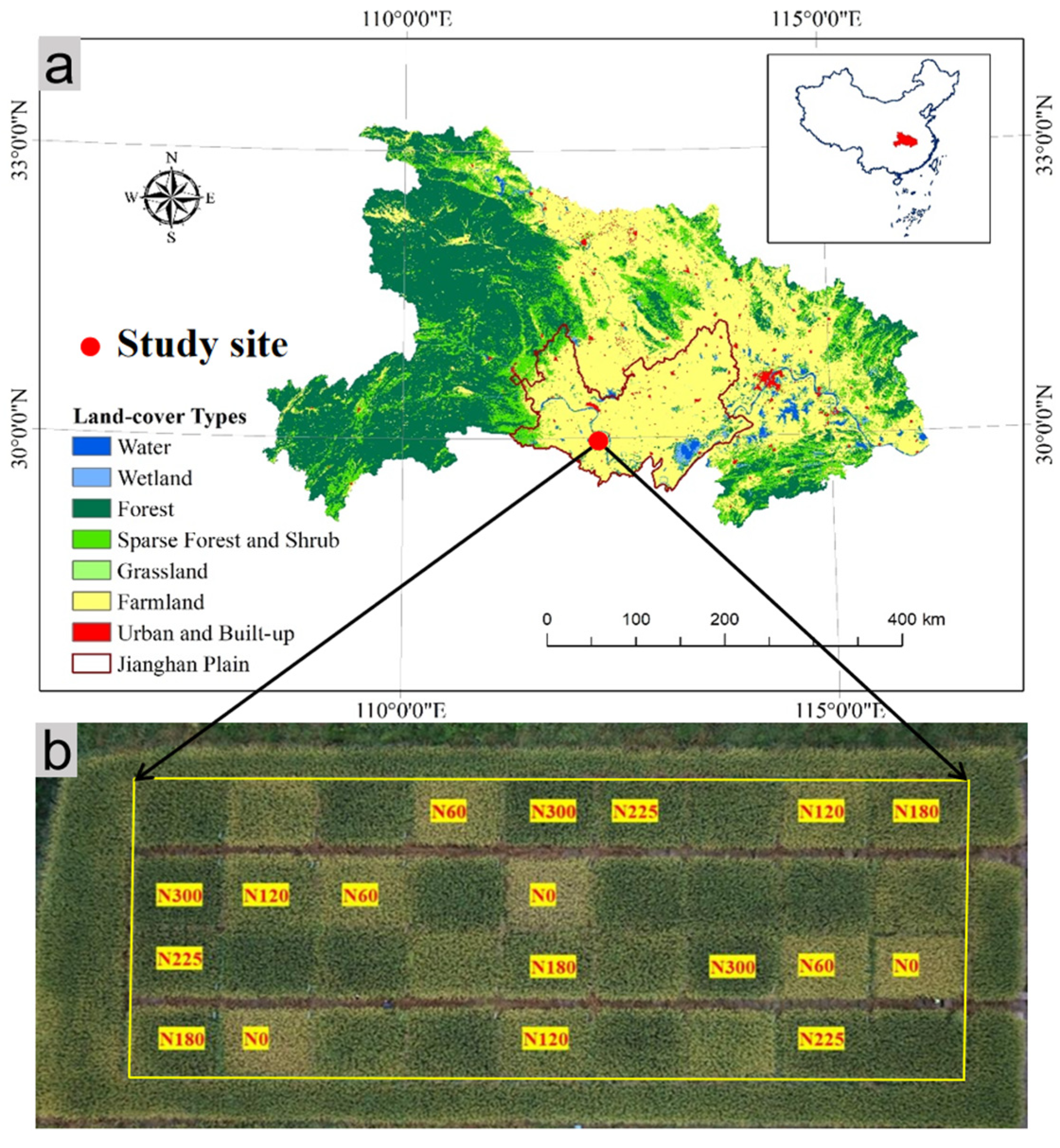
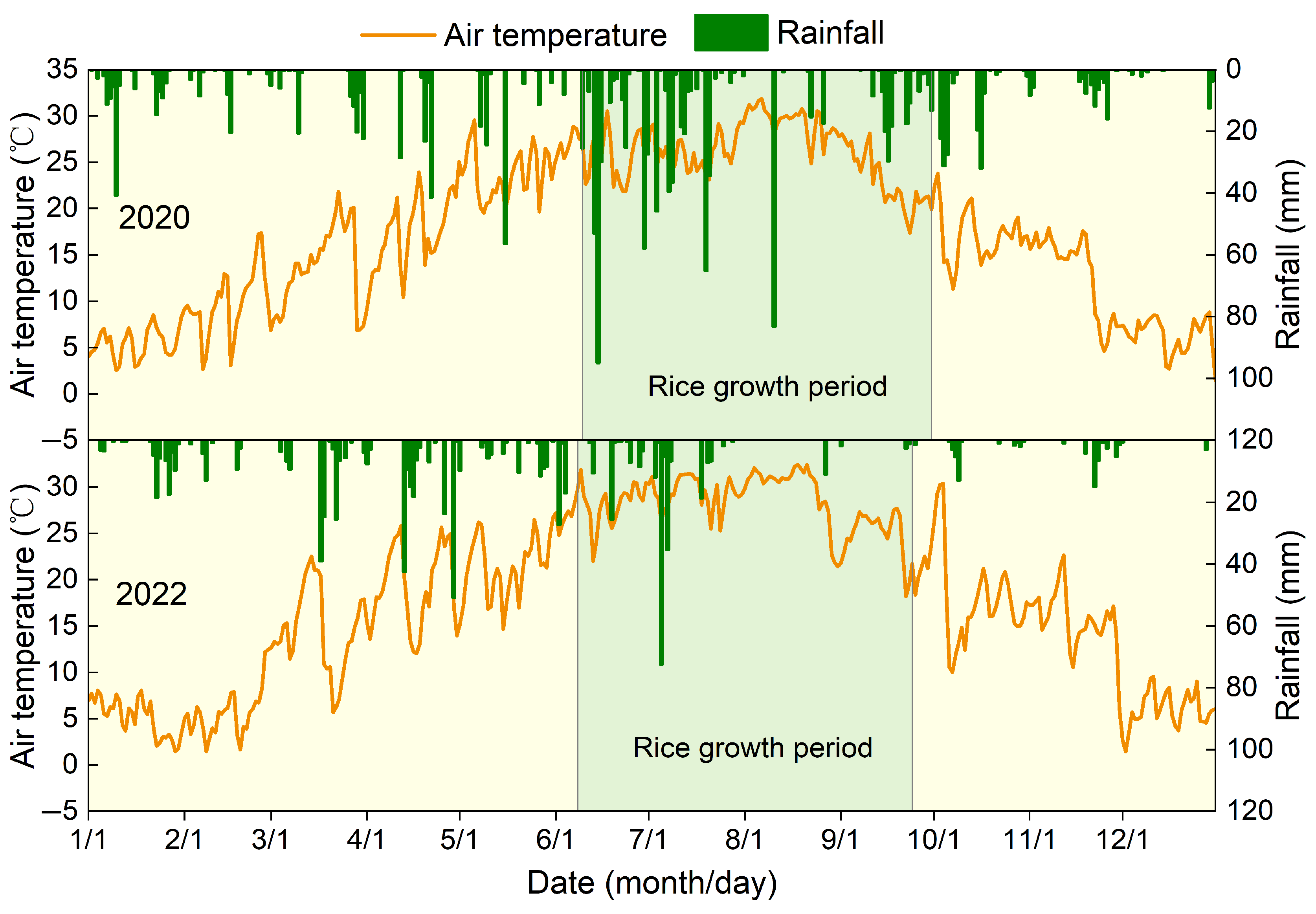
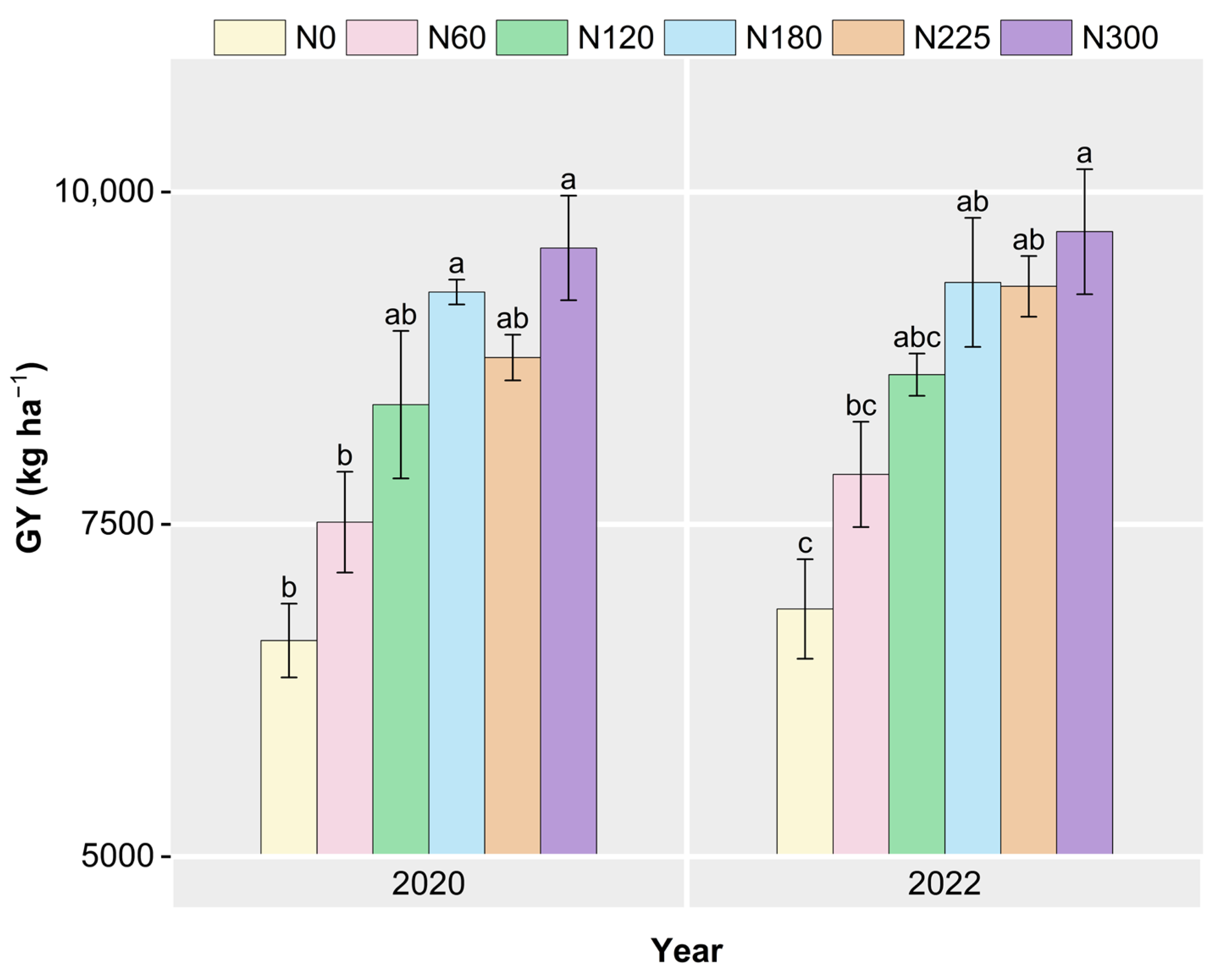

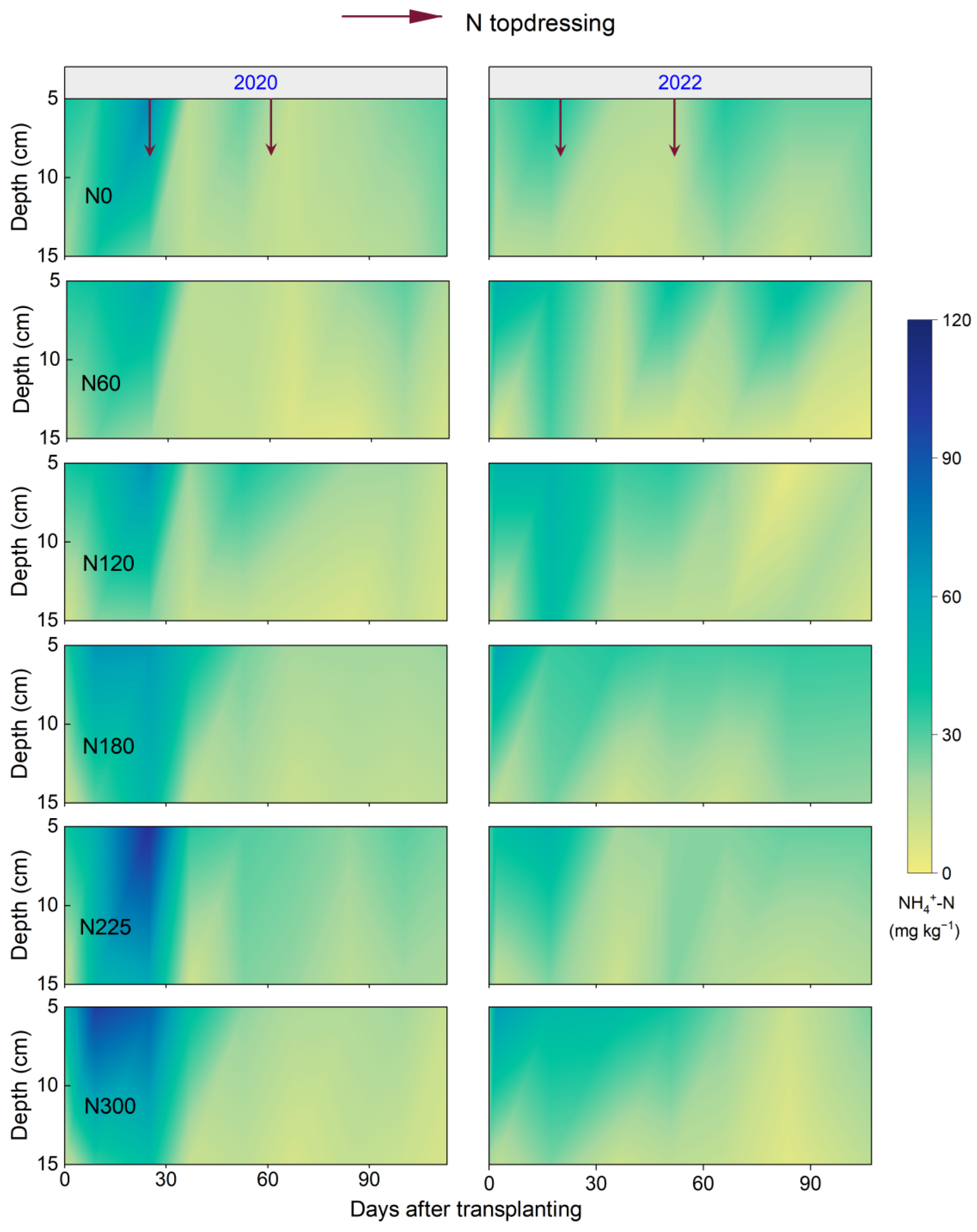
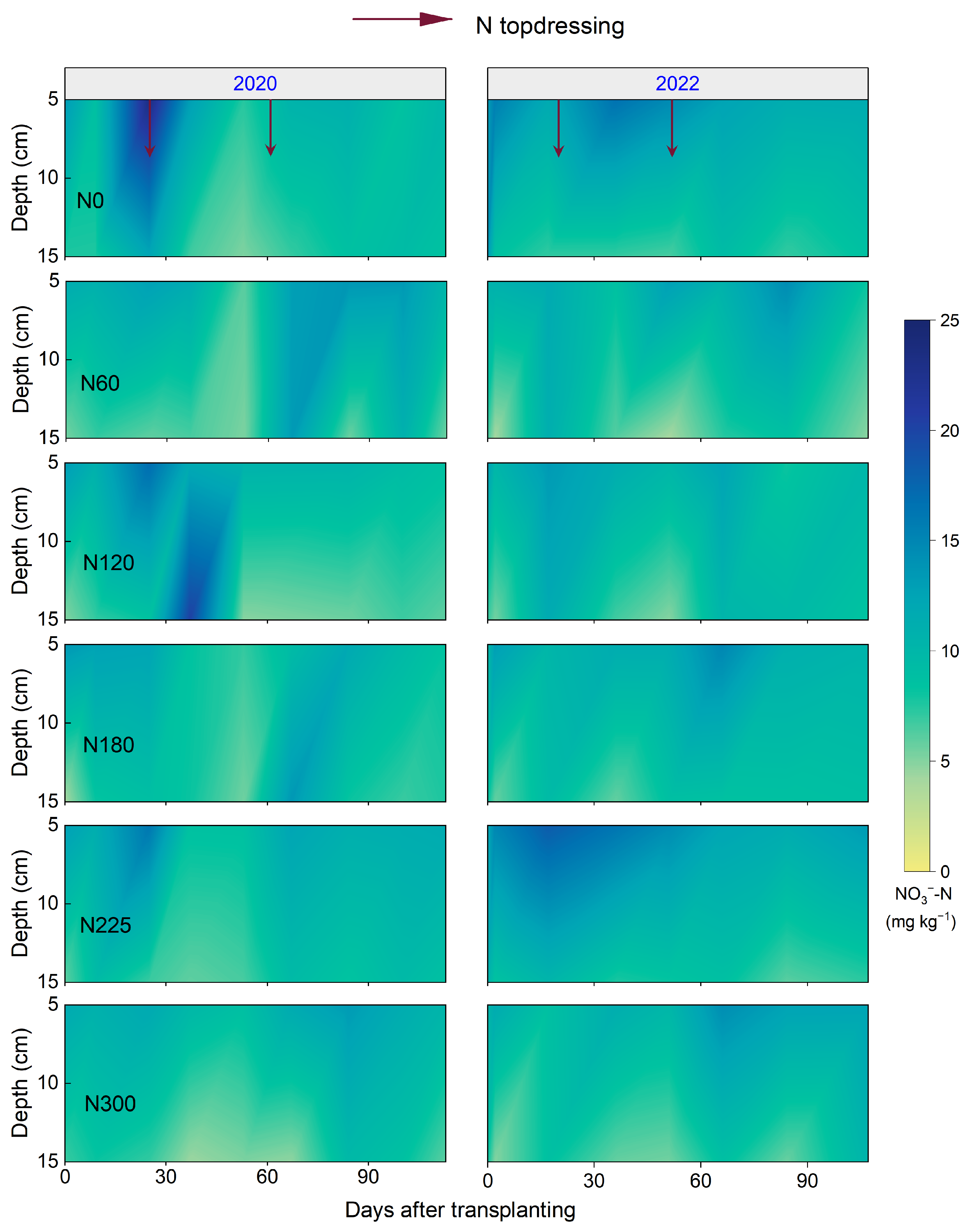
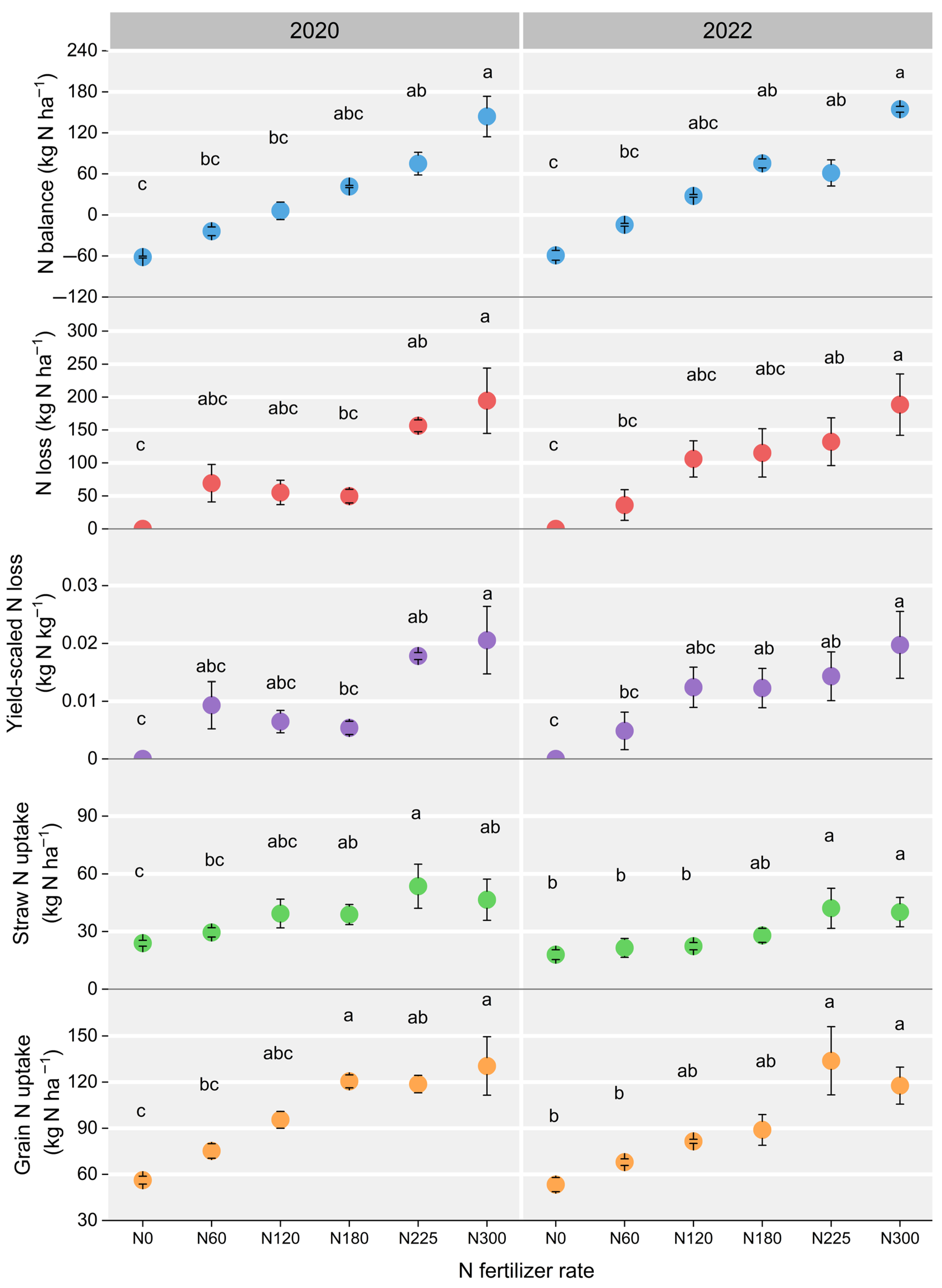
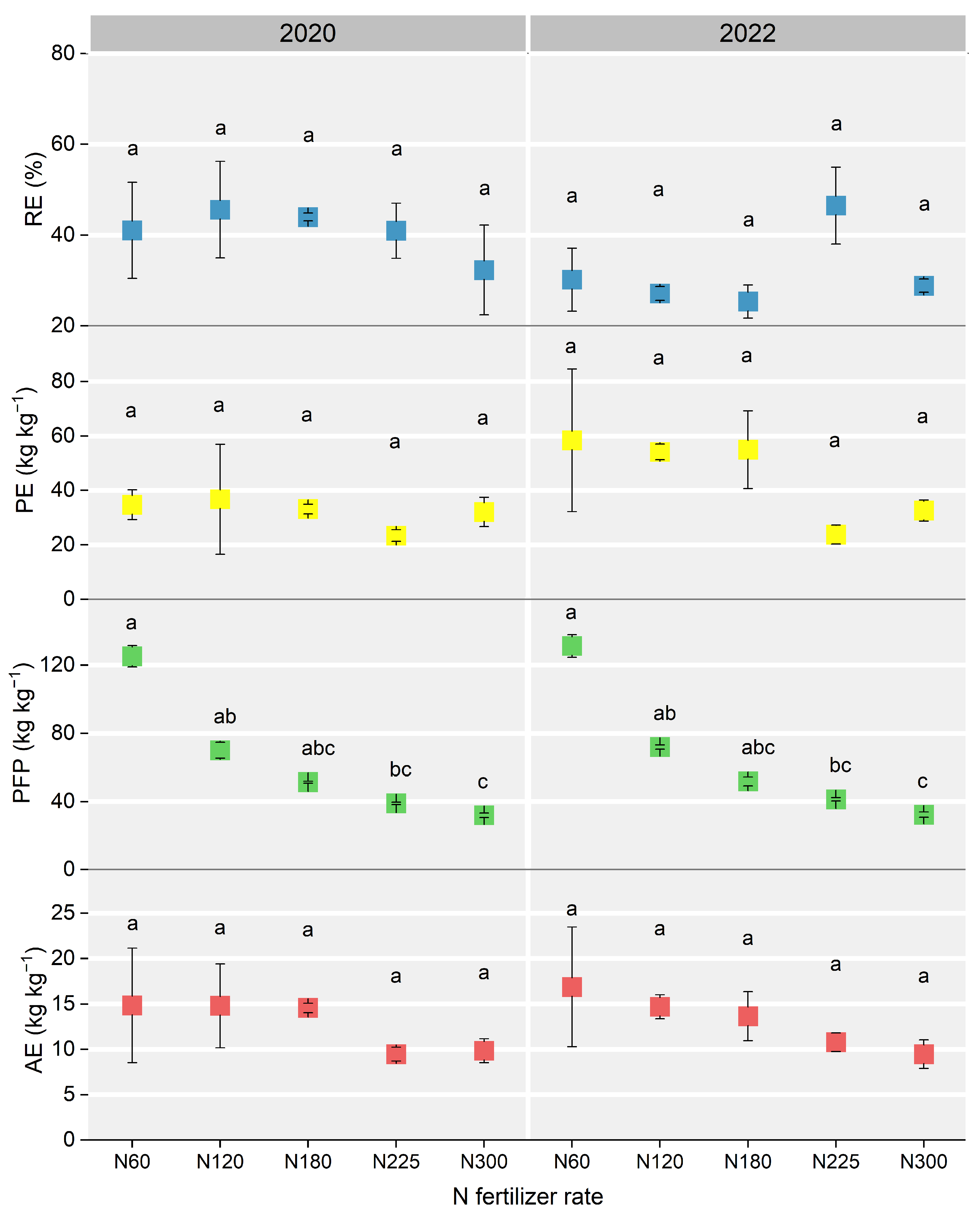

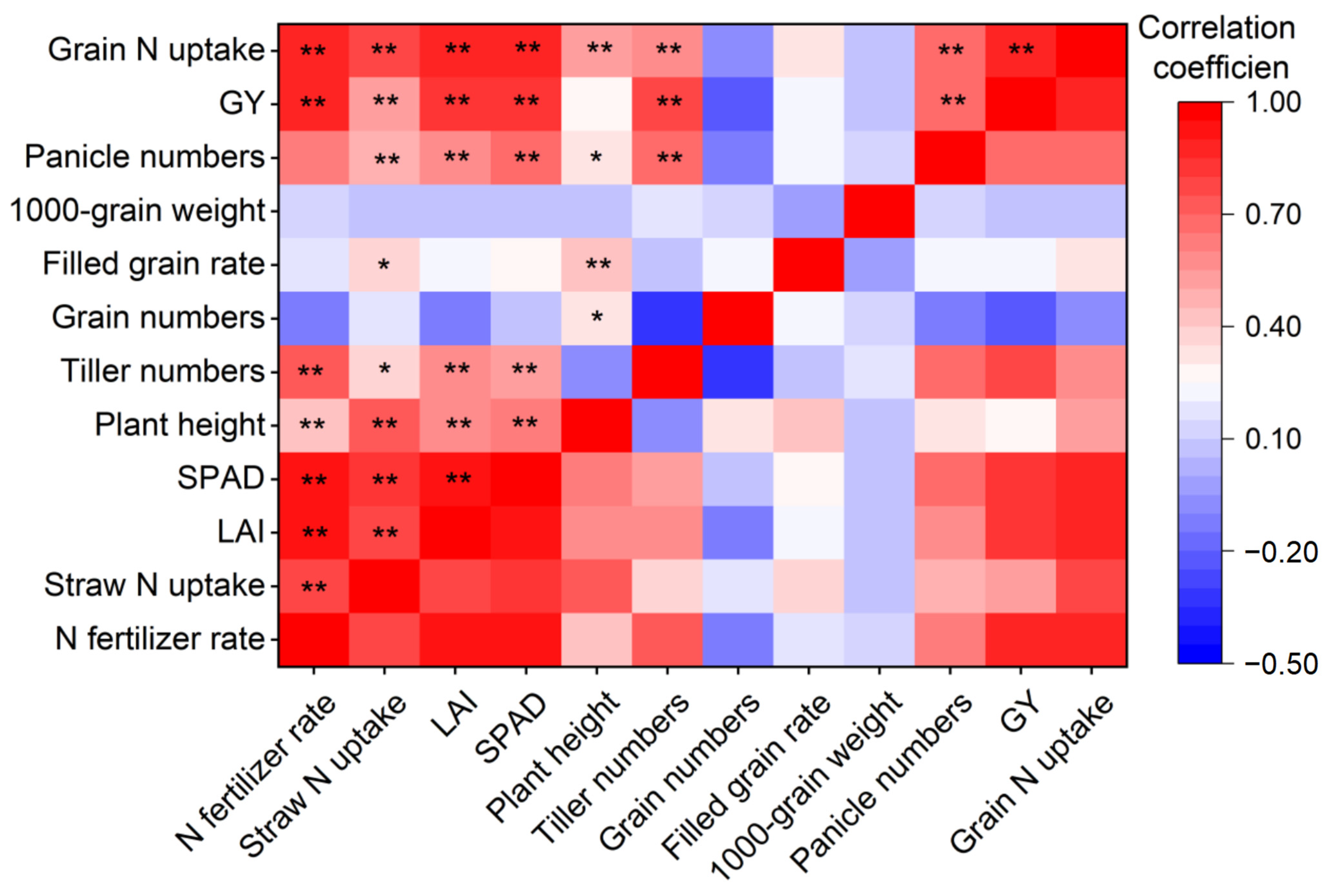
| N Fertilizer Level | Panicle Number Per Hill (-) | Grain Number Per Panicle (-) | Filled Grain Rate (%) | 1000-Grain Weight (g) | |||
|---|---|---|---|---|---|---|---|
| 2020 | 2022 | 2020 | 2022 | 2020 | 2022 | 2022 | |
| N0 | 12.1 ± 2.1 b | 12.3 ± 1.7 b | 228.5 ± 77.2 a | 221.5 ± 58.8 ab | 92.4 ± 5.5 b | 85.5 ± 6.2 b | 19.8 ± 3.4 a |
| N60 | 12.8 ± 2.5 b | 14.2 ± 3.2 ab | 229.1 ± 82.7 a | 200.4 ± 60.6 b | 93.1 ± 7.4 ab | 89.7 ± 4.3 a | 18.0 ± 3.1 a |
| N120 | 15.7 ± 3.4 a | 16.3 ± 3.5 a | 222.1 ± 48.0 a | 228.3 ± 53.6 a | 94.9 ± 5.3 a | 89.9 ± 9.9 ab | 21.2 ± 2.2 a |
| N180 | 16.9 ± 3.3 a | 15.5 ± 2.3 a | 219.4 ± 48.0 a | 201.1 ± 47.1 ab | 94.9 ± 5.4 a | 93.0 ± 5.7 a | 19.4 ± 1.3 a |
| N225 | 15.5 ± 3.0 a | 14.7 ± 2.1 a | 253.4 ± 45.5 a | 203.7 ± 39.8 ab | 95.0 ± 4.7 a | 92.7 ± 3.4 a | 19.2 ± 0.3 a |
| N300 | 16.6 ± 2.6 a | 15.7 ± 3.8 ab | 226.0 ± 68.7 a | 195.5 ± 60.8 b | 90.2 ± 9.8 b | 92.1 ± 4.7 a | 20.6 ± 4.5 a |
Disclaimer/Publisher’s Note: The statements, opinions and data contained in all publications are solely those of the individual author(s) and contributor(s) and not of MDPI and/or the editor(s). MDPI and/or the editor(s) disclaim responsibility for any injury to people or property resulting from any ideas, methods, instructions or products referred to in the content. |
© 2025 by the authors. Licensee MDPI, Basel, Switzerland. This article is an open access article distributed under the terms and conditions of the Creative Commons Attribution (CC BY) license (https://creativecommons.org/licenses/by/4.0/).
Share and Cite
Xu, T.; Zhang, H.; Gong, J.; Wang, L.; Wang, Y.; Qiu, W.; Liu, M.; Li, S.; Fei, Y.; Li, Q.; et al. Optimizing Nitrogen Fertilizer Rate and Investigating Mechanism Driving Grain Yield Increase for Rice in the Middle Reaches of the Yangtze River. Plants 2025, 14, 2326. https://doi.org/10.3390/plants14152326
Xu T, Zhang H, Gong J, Wang L, Wang Y, Qiu W, Liu M, Li S, Fei Y, Li Q, et al. Optimizing Nitrogen Fertilizer Rate and Investigating Mechanism Driving Grain Yield Increase for Rice in the Middle Reaches of the Yangtze River. Plants. 2025; 14(15):2326. https://doi.org/10.3390/plants14152326
Chicago/Turabian StyleXu, Tianxiang, Hailin Zhang, Jie Gong, Ling Wang, Yongsheng Wang, Weiwen Qiu, Muxing Liu, Shenglong Li, Yuanhang Fei, Qi Li, and et al. 2025. "Optimizing Nitrogen Fertilizer Rate and Investigating Mechanism Driving Grain Yield Increase for Rice in the Middle Reaches of the Yangtze River" Plants 14, no. 15: 2326. https://doi.org/10.3390/plants14152326
APA StyleXu, T., Zhang, H., Gong, J., Wang, L., Wang, Y., Qiu, W., Liu, M., Li, S., Fei, Y., Li, Q., Ni, X., Yi, J., & Huang, C. (2025). Optimizing Nitrogen Fertilizer Rate and Investigating Mechanism Driving Grain Yield Increase for Rice in the Middle Reaches of the Yangtze River. Plants, 14(15), 2326. https://doi.org/10.3390/plants14152326








